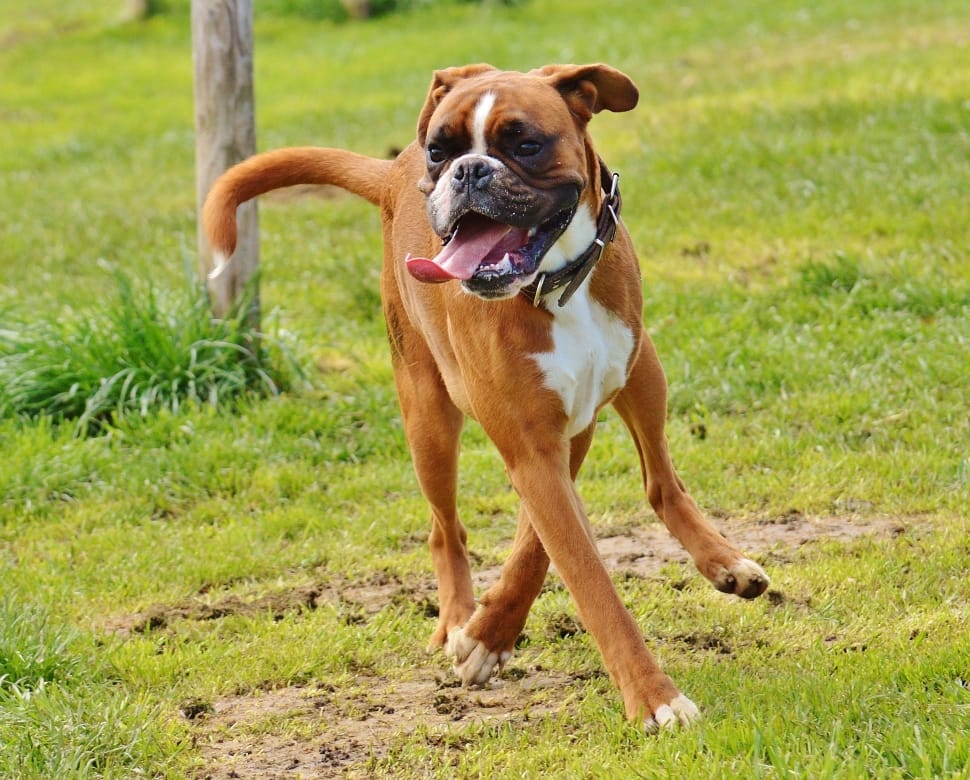The Top 9 Dog Breeds With Long Tongues
The St. Bernard is often depicted toting a barrel under their collar as they rescue hikers and skiers from beneath an avalanche. After being trapping in snow and ice, a large, warm tongue to the side of your cheek may actually be welcome.
Of course, it makes sense that big dogs have long tongues. But don’t just take our word for it — it’s been made official! The current Guinness World Record holder for the longest dog tongue goes to a St. Bernard named Mochi. With the winning measurement coming in at 7.3 inches, Mochi, a rescue dog, lives with her proud owners in South Dakota.

With their short snouts and snubbed nose, a Boxer’s tongue doesn’t have much room to hide. In fact, the same can be said for all the snubbed nose dog breeds on our list.
However, it’s a Boxer that holds the distinction of the Guinness World Record for longest dog tongue ever. Until her death in 2002, Brandy the Boxer held the record for a whopping 17-inch tongue.
For those of you who prefer smaller dogs, you don’t have to give up much in relative tongue length with a Pekingese. It’s not uncommon for this dog breed with a tiny snout to sport a long tongue hanging out of their mouths.
Puggy, a Pekingese with a misleading name, held the longest dog tongue Guinness World Record for a time. Her tongue measures 4.5 inches, which is impressive for such a small pup.
If you love looking at pictures of all the easygoing pugs displayed across numerous social media accounts, then you’ll notice that long tongue adding interest to the Pug’s smiling face.
When raised in a loving environment, Pits just want to use their powerful bodies for affection, and they’ve got plenty of tongue length for extra sloppy dog kisses.
Don’t count out a Rottweiler’s long tongue. It’s hard to miss one this good-natured dog breed!
Labradors are annually listed as the most popular dog breed, and the secret to their popularity may be their long tongues. It’s hard to resist a Lab’s attractive smiling features at a full pant.
The Labrador’s long-haired cousin must also get a mention for an equally long and expressive tongue. When you’re going in for a hug of this cuddly dog breed, you might get a sneak attack dog kiss from that long tongue.
You don’t have to look hard to notice the Husky’s long tongue swaying in the breeze as they compete in their favorite event, dogsledding.
While a St. Bernard, a Boxer, and a Pekingese may dominate the world record books, you never know which dog breed may rise — or rather, stretch — to the challenge of earning the longest dog tongue. In our humble opinion, two types of dog breeds have the edge for producing long dog tongues.
As stated previously, since they don’t have much mouth space, snubbed nose dog breeds have nowhere for their tongues to go but out. Beyond Boxers, Pit Bulls, Pekingese, and Pugs, you’ll potentially find long tongues on Bulldogs, Boston Terriers, Shih Tzus, Lhasa Apso, Chow Chows, and Mastiffs.
Mastiffs have the advantage for a long tongue in a second category, large breed dogs. If you’re searching for a long tongue, you’ll surely increase your chances of finding it on a big dog, such as a Newfoundland, Bernese Mountain Dog, Great Dane, Irish Wolfhound, Great Pyrenees, or Alaskan Malamute.
What dog breeds have the longest tongues?
The current Guinness World Record holder for the longest dog tongue goes to a St. Bernard named Mochi. With the winning measurement coming in at 7.3 inches, Mochi, a rescue dog, lives with her proud owners in South Dakota.
What animal has the cleanest mouth?
Therefore, we can actually say that a dog’s mouth is as clean as his owner wants it to be. With all the dentistry toys for dogs that they can chew on and thus clean their teeth, it looks like our canine friends might have, after all, the leading position in the animals with the cleanest mouths top.
The 10 Dog Breeds That Live The Longest
Whether it’s getting every last morsel of food from their bowl, panting after a game of fetch, or showering you with affection, a dog’s tongue plays an important role in how they interact with their environment.